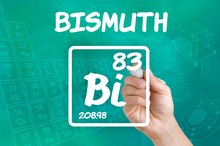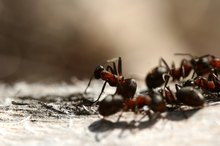Poisons That Make Hair Fall Out
Hair loss, or alopecia, can be a side effect of toxic chemicals and metals. Hair loss does not usually occur with acute poisoning, which can be lethal. But in cases of chronic poisoning, when the poison is taken in small doses over a long period of time, hair loss is a common symptom. Hair loss can also be a sign that your body has been exposed to an environmental hazard.
Arsenic
Arsenic is a naturally occurring element that is also a popular poisoning agent in literature and cinema. It is used in industry as a preservative in “pressure-treated” lumber and as a pesticide. Arsenic from the soil, air and water can be inhaled or can enter the food chain, where it can be consumed by humans. Arsenic poisoning can become a chronic disorder if small amounts are ingested or inhaled over a long period. According to Serita Stevens’ and Anne Bannon’s “Book of Poisons,” hair loss is a common symptom in chronic arsenic poisoning 1.
- Arsenic is a naturally occurring element that is also a popular poisoning agent in literature and cinema.
- Arsenic from the soil, air and water can be inhaled or can enter the food chain, where it can be consumed by humans.
Boric Acid
Toxic Vapors Emitted From New Tires
Learn More
Boric acid, derived from the natural compound boron, is a dangerous poison that can have an acute or chronic effect. It is used to make many products, including glass, roach-killing products, fire retardants, skin lotions, cosmetics and cleaning products. Historically it was used to disinfect and treat wounds. Boric acid is toxic when inhaled or ingested. The “Merck Manual of Diagnosis and Therapy” states that chronic boric acid poisoning can cause anagen effluvium, which is hair loss caused when a toxic chemical interferes with the first phase of the hair growth cycle, known as the anagen phase 2.
- Boric acid, derived from the natural compound boron, is a dangerous poison that can have an acute or chronic effect.
- It is used to make many products, including glass, roach-killing products, fire retardants, skin lotions, cosmetics and cleaning products.
Thallium
Thallium is a trace metal that enters the environment mainly from coal-burning and metal-smelting industries. It is used in making semiconductor devices, and is found in cigarette smoke, since it is absorbed by tobacco during cultivation. Thallium poisoning comes mainly from inhaling it, smoking cigarettes and from food. Thallium enters the food chain through plants and fish, and is eventually consumed by humans. According to the Agency for Toxic Substances and Disease Registry, ingesting large amounts of thallium over a short time can cause temporary hair loss 3.
- Thallium is a trace metal that enters the environment mainly from coal-burning and metal-smelting industries.
- Thallium poisoning comes mainly from inhaling it, smoking cigarettes and from food.
Meadow Saffron
Nutritional Benefits of the Element Bismuth
Learn More
Meadow saffron (Colchicum autumnale) is a flowering plant similar to a crocus, but highly toxic. Historically, the root and seeds were used to treat gout and rheumatism. Meadow saffron contains a toxic alkaloid called colchicine, which can be fatal even in small doses. According to the National Institute for Occupational Safety and Health, chronic or repeated exposure to the colchicine in meadow saffron can lead to hair loss.
- Meadow saffron (Colchicum autumnale) is a flowering plant similar to a crocus, but highly toxic.
- Meadow saffron contains a toxic alkaloid called colchicine, which can be fatal even in small doses.
Lead
Lead is a metal used in industries involved in burning fossil fuels, mining and manufacturing. Lead is found in many products, including batteries, solder used on pipes and ammunition. It can be inhaled or ingested with food and water. Lead can cause many disorders, including brain damage, anemia and cancer. According to the University of Michigan Health System, hair loss is one of the symptoms of severe lead poisoning.
- Lead is a metal used in industries involved in burning fossil fuels, mining and manufacturing.
- Lead is found in many products, including batteries, solder used on pipes and ammunition.
Related Articles
References
- “Book of Poisons”; Serita Stevens, RN, BSN, MA, LNC, and Anne Bannon; 2007
- Merck Manual of Diagnosis and Therapy
- Agency for Toxic Substances and Disease Registry
Writer Bio
Janet Contursi has been a writer and editor for more than 23 years. She has written for professional journals and newspapers, and has experience editing educational, cultural, and business articles and books. Her clients include Gale Publishers, Anaxos, Vielife and Twin Cities Wellness. Contursi earned her Ph.D. at the University of Minnesota, where she studied cultural anthropology, South Asian languages and culture, and art history.









